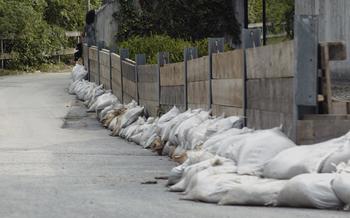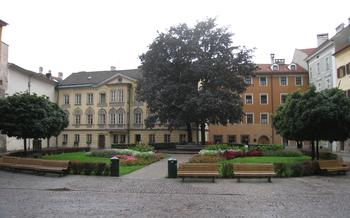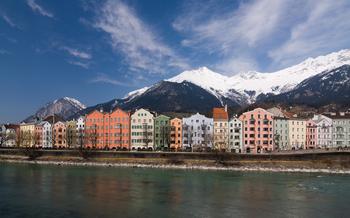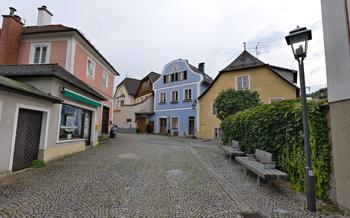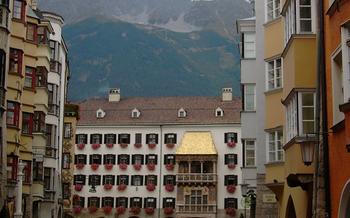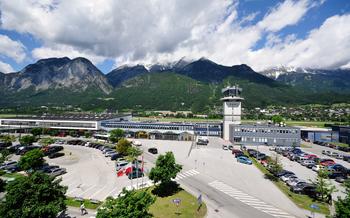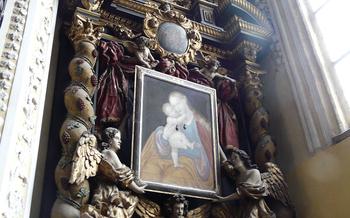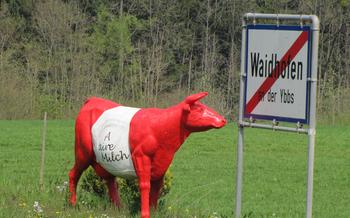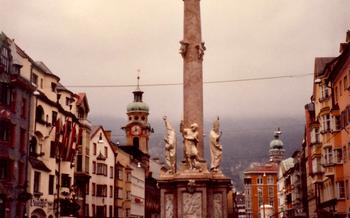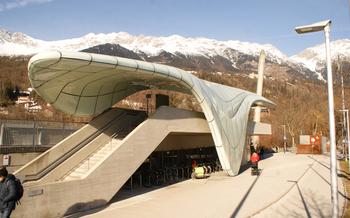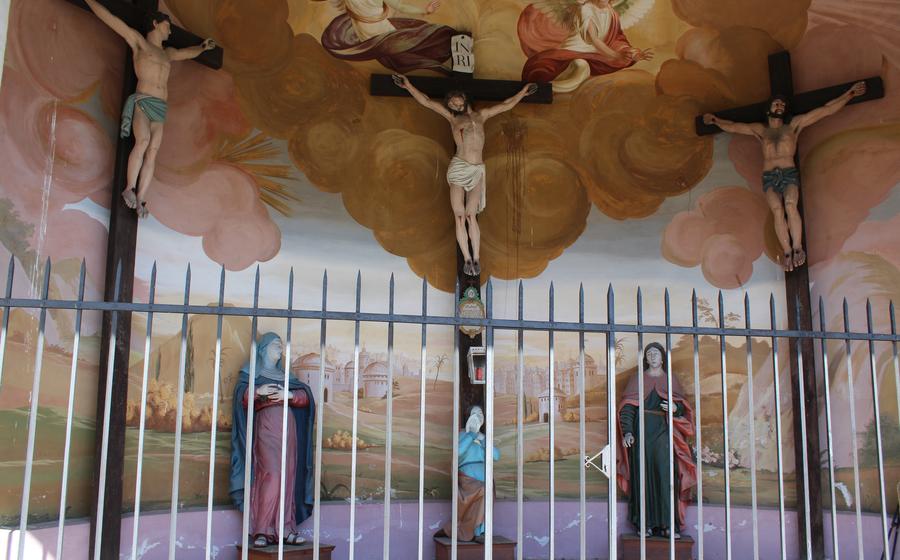
Hungerburg Funicular
- The Hungerburg Funicular: A Unique Alpine Experience
- Getting to Hungerburg Funicular:
- Ticket Prices and Operating Hours:
- Hungerburg Station and Surrounding Area
- Nordpark Cable Car (Seegrube)
- Hafelekarspitze Peak: Innsbruck's Majestic Summit
- The Alpenzoo Innsbruck
- The Swarovski Crystal Worlds
- Imperial Splendor: Exploring the Imperial Palace of Innsbruck
- The Golden Roof
- The Hofburg
- The Hofkirche
- Insider Tip: Embracing the Innsbruck Festival of Early Music
The Hungerburg Funicular: A Unique Alpine Experience
The Hungerburg Funicular, also known as the Nordkettenbahnen, is a remarkable feat of engineering that offers visitors a thrilling and unforgettable journey into the heart of the Nordkette Mountains. Inaugurated in 1906, this iconic funicular has been a beloved attraction for over a century, transporting passengers from the city center of Innsbruck to the Hungerburg Plateau, a breathtaking vantage point with panoramic views of the Tyrolean Alps.
The Hungerburg Funicular consists of two parallel funicular lines that ascend the steep slopes of the Nordkette. The journey begins at the Congress station in the heart of Innsbruck, where passengers board the sleek and modern funicular cars. The ascent is a thrilling experience, as the cars climb steadily through lush forests and over dramatic gorges, providing breathtaking views of the city and the surrounding mountains.
At the halfway point, the funicular stops at the Verbindungsbahn station, where passengers can transfer to the Nordpark Cable Car to continue their journey to the Seegrube, a popular hiking and skiing destination. Alternatively, they can disembark and explore the Hungerburg Plateau, which offers a variety of hiking trails, restaurants, and cafes.
The Hungerburg Funicular is not only a convenient mode of transportation but also an architectural marvel. The funicular stations, designed by the renowned architect Zaha Hadid, are striking examples of contemporary architecture, blending seamlessly into the surrounding landscape. The Hungerburg station, in particular, is a masterpiece of design, featuring a futuristic glass and steel structure that appears to float above the ground.
Getting to Hungerburg Funicular:
To reach the Hungerburg Funicular from Innsbruck city center, you have several convenient options:
-
Walking: If you enjoy a leisurely stroll, you can walk from the city center to the Hungerburgbahn station in about 30-45 minutes. Follow signs or use a map app to guide you.
-
Public Transportation: Innsbruck's efficient public transportation system offers several bus lines that stop near the Hungerburgbahn station. Lines 1, 3, and 5 are particularly convenient. Alternatively, you can take tram line 6 to the Congress station and then transfer to bus line
-
Parking: If you prefer to drive, there are several parking options near the Hungerburgbahn station. The Hungerburg car park, located directly next to the station, offers both short-term and long-term parking. Alternatively, you can park at the Congress car park and take a short walk or bus ride to the station.
Ticket Prices and Operating Hours:
The Hungerburg Funicular offers a range of ticket options to suit different needs and budgets. Adult tickets currently cost 11 euros for a one-way journey and 18 euros for a round-trip. Children between the ages of 6 and 15 are eligible for discounted tickets at 6 euros for a one-way trip and 10 euros for a round-trip. Families with children can purchase a family ticket, which includes two adults and two children, for 38 euros for a round-trip.
The Hungerburg Funicular operates daily, with departures every 15 minutes during peak season and every 20 minutes during the off-season. The first departure from the Congress station is at 7:30 am, and the last departure is at 11:00 pm. From the Hungerburg station, the first departure is at 8:00 am, and the last departure is at 10:30 pm.
To save money, consider purchasing a combined ticket that includes admission to the Hungerburg Funicular and other attractions in Innsbruck, such as the Imperial Palace or the Swarovski Crystal Worlds. These combined tickets offer significant discounts and can be purchased online or at the Innsbruck Visitor Information Center.
Hungerburg Station and Surrounding Area
Disembarking at Hungerburg Station, you'll find yourself on the Hungerburg Plateau, a vibrant hub of activity and natural beauty. Take some time to explore this charming area before venturing further up the mountain.
Start by strolling along the scenic promenade that leads to the Nordkette Cable Car station. Along the way, admire the stunning panoramic views of Innsbruck and the surrounding mountains. Stop at one of the many viewpoints to capture some breathtaking photos.
For those seeking a more active experience, there are numerous hiking trails that start from the Hungerburg Plateau. Choose from easy walks suitable for families to challenging treks that lead to the summit of the Nordkette.
After exploring the natural wonders, indulge in some retail therapy or culinary delights at the Hungerburg Plateau. Browse through the charming shops offering souvenirs and local products. Treat yourself to a delicious meal at one of the restaurants, cafes, or bars, many of which offer outdoor seating with panoramic views.
One of the highlights of the Hungerburg Plateau is the Alpenzoo Innsbruck, a unique alpine zoo that houses over 2,000 animals from the Alpine region. Observe native species such as ibex, marmots, and eagles in their natural habitats. Learn about the importance of conservation and the zoo's efforts to protect these magnificent creatures.
Nordpark Cable Car (Seegrube)
From the Hungerburg Station, you can take the connecting Nordpark Cable Car to Seegrube, a scenic mountaintop located at an elevation of 1,905 meters. The cable car journey offers breathtaking views of the Karwendel and Wetterstein mountain ranges, as well as the Nordkette Mountains and the city of Innsbruck below. Once you reach the Seegrube Station, you'll be greeted by a stunning panorama that will leave you in awe.
At the Seegrube, you can embark on various hiking and mountain biking trails that offer unique perspectives of the surrounding landscapes. The area is a haven for outdoor enthusiasts, with trails catering to different skill levels. Take a leisurely stroll along the Panoramaweg trail to soak in the breathtaking views, or challenge yourself with the more demanding trails that lead to the surrounding peaks.
Hafelekarspitze Peak: Innsbruck's Majestic Summit
Ascend to the summit of the Hafelekarspitze, Innsbruck's highest peak, and be rewarded with breathtaking panoramic views that stretch as far as the eye can see. At an elevation of 2,334 meters (7,657 feet), the Hafelekarspitze offers an unparalleled perspective of the surrounding mountain ranges, including the majestic Karwendel and Wetterstein peaks.
The journey to the summit is an adventure in itself, as you glide up the steep slopes in a modern cable car, passing through diverse alpine terrain and catching glimpses of wildlife along the way. Once at the top, you'll find yourself in a breathtaking high-altitude landscape, with rugged peaks, lush meadows, and sparkling lakes painting a picture of natural splendor.
For those seeking an exhilarating challenge, the Hafelekarspitze is a haven for hikers and mountain climbers. Numerous well-marked trails lead from the summit, offering varying levels of difficulty and stunning vistas at every turn. Whether you choose to embark on a leisurely stroll or a challenging ascent, the Hafelekarspitze offers an unforgettable experience for outdoor enthusiasts.
Along the way, you'll encounter rustic mountain huts, where you can rest, refuel, and soak in the stunning scenery. These huts offer traditional Tyrolean cuisine, providing a taste of local flavors amidst the alpine wilderness.
As the sun begins to set, the Hafelekarspitze transforms into a magical realm, bathed in a golden glow that casts a warm hue across the surrounding peaks. Whether you choose to spend the night at one of the mountain huts or descend back to Innsbruck, the memories of your time at the summit will linger long after your visit.
The Alpenzoo Innsbruck
Nestled amidst the stunning alpine landscapes of Hungerburg, the Alpenzoo Innsbruck offers a unique opportunity to encounter the fascinating world of native Alpine animals. Established in 1962, this remarkable zoo is dedicated to preserving and showcasing the rich biodiversity of the region.
As you explore the zoo's spacious enclosures, you'll have the chance to observe a diverse array of creatures in their natural habitats. From majestic ibex and graceful chamois to playful marmots and adorable Alpine salamanders, the Alpenzoo provides a glimpse into the extraordinary wildlife that thrives in the heart of the Alps.
Through interactive exhibits and educational displays, the Alpenzoo raises awareness about the importance of conservation and the delicate balance of alpine ecosystems. Learn about the threats facing these incredible animals and the ongoing efforts to protect their habitats.
A visit to the Alpenzoo is not just an educational experience but also a journey of wonder and inspiration. As you witness the beauty and resilience of these alpine creatures, you'll gain a deeper appreciation for the fragility of our natural world and the urgent need to preserve it for future generations.
The Swarovski Crystal Worlds
For a touch of glamour and sparkle, visit the Swarovski Crystal Worlds, a museum and art installation dedicated to the world-famous crystal brand. Immerse yourself in the dazzling displays of crystal creations, sculptures, and artworks, showcasing the company's rich history and heritage. Discover the artistry and craftsmanship behind these exquisite pieces and learn about the innovative techniques used to create them. The museum offers a unique and enchanting experience for visitors of all ages, making it a must-visit attraction in Innsbruck.
Imperial Splendor: Exploring the Imperial Palace of Innsbruck
Innsbruck's Imperial Palace stands as a testament to the grandeur and legacy of the Habsburg dynasty, the former rulers of the Austro-Hungarian Empire. Built in the 15th century, this opulent palace served as their residence in the city, providing a glimpse into the lives and reign of one of Europe's most influential families.
Step through the grand entrance and be captivated by the intricate architecture and opulent interiors. Admire the beautifully preserved Renaissance-style arcades, elegant ballrooms adorned with shimmering chandeliers, and majestic staterooms showcasing exquisite tapestries and paintings. Each room tells a story of the Habsburgs' reign, revealing their taste for grandeur and their role in shaping the history of Innsbruck.
Take a leisurely stroll through the palace's sprawling gardens, where manicured lawns, vibrant flower beds, and serene fountains create a tranquil oasis amidst the city's bustle. Admire the perfectly sculpted hedges, fragrant rose gardens, and hidden fountains, providing a glimpse into the Habsburgs' love of nature and their desire to create a private sanctuary within their palace grounds.
Immerse yourself in the rich history of the Habsburgs by visiting the palace's museums. Learn about the lineage, achievements, and personal lives of the dynasty's most prominent rulers, such as Emperor Maximilian I, known for his patronage of the arts, and Empress Maria Theresia, who ruled with strength and wisdom during the 18th century.
As you wander through the Imperial Palace, you can't help but feel a sense of awe and admiration for the Habsburg dynasty. Their legacy lives on in the grand halls and opulent interiors of this magnificent palace, a symbol of their power, influence, and enduring impact on Innsbruck's history and culture.
The Golden Roof
In the heart of Innsbruck's Old Town, nestled amidst charming medieval buildings, lies a captivating landmark that has become synonymous with the city's rich history and architectural heritage: the Golden Roof. This iconic structure, known locally as the "Goldenes Dachl," is a magnificent testament to the artistry and craftsmanship of the Renaissance era.
Originally built in the 15th century as a balcony for Emperor Maximilian I to observe tournaments and festivities in the square below, the Golden Roof is adorned with over 2,657 fire-gilded copper tiles that shimmer and gleam in the sunlight. The intricate designs and motifs depicted on these tiles showcase a blend of Gothic and Renaissance influences, with representations of royalty, mythical creatures, and scenes from everyday life.
As you stand beneath the Golden Roof, gazing up at its resplendent facade, you can't help but feel transported back in time. Imagine the lively atmosphere of jousting tournaments, the vibrant colors of medieval costumes, and the fanfare of trumpets echoing through the square. The Golden Roof serves as a reminder of Innsbruck's illustrious past, when it was a prominent center of power and culture within the Holy Roman Empire.
Today, the Golden Roof is one of Innsbruck's most popular tourist attractions, drawing visitors from around the world. It is a symbol of the city's pride and a must-see for anyone interested in history, architecture, or simply admiring the beauty of a bygone era. Capture stunning photographs of this architectural gem, and let its golden tiles transport you to a time when Innsbruck was a thriving hub of imperial grandeur.
The Hofburg
Situated in the heart of Innsbruck's Old Town, the Hofburg stands as a testament to the grandeur and power of the Habsburg dynasty. Originally constructed in the 14th century, this former imperial palace has undergone numerous expansions and renovations over the centuries, resulting in a fascinating blend of architectural styles. Explore the staterooms, which once hosted lavish banquets and diplomatic gatherings, and admire the opulence of the Giant Hall, renowned for its impressive ceiling frescoes. Delve into the history of the Habsburgs at the museum housed within the palace, and immerse yourself in the imperial legacy that shaped Innsbruck's destiny. Stroll through the picturesque gardens and courtyards, which offer a tranquil oasis amidst the bustling city, and soak in the grandeur of this magnificent architectural masterpiece.
The Hofkirche
Nestled in the heart of Innsbruck's Old Town, the Hofkirche (Court Church) stands as a testament to the artistic and spiritual heritage of the city. Founded by Emperor Maximilian I in the early 16th century, this magnificent Gothic church is renowned for its awe-inspiring architecture, intricate carvings, and stunning stained-glass windows.
As you step inside the Hofkirche, the sheer grandeur of the interior will take your breath away. The soaring vaulted ceilings, supported by slender columns, create a sense of spaciousness and light. The walls are adorned with intricate carvings depicting scenes from the Bible and the life of Emperor Maximilian I.
One of the highlights of the Hofkirche is the elaborate cenotaph, or empty tomb, of Emperor Maximilian I. This magnificent work of art, crafted from bronze and marble, features 28 larger-than-life bronze statues of the emperor's ancestors and contemporaries. Each statue is exquisitely detailed, capturing the individual characteristics and personalities of these historical figures.
In addition to the cenotaph, the Hofkirche is home to a number of other notable works of art, including the Silver Chapel, which houses a collection of precious silver objects, and the Stained Glass Windows, which depict scenes from the life of Christ.
Whether you are a history buff, an art enthusiast, or simply someone who appreciates beauty, the Hofkirche is a must-visit attraction in Innsbruck. This awe-inspiring church will leave you with a lasting memory of your time in this historic city.
Insider Tip: Embracing the Innsbruck Festival of Early Music
For an unforgettable cultural experience, plan your visit to Innsbruck during the annual Innsbruck Festival of Early Music. This prestigious festival showcases the finest classical music performances in stunning historical venues throughout the city. Immerse yourself in the enchanting atmosphere as world-renowned musicians bring masterpieces from the Renaissance and Baroque eras to life. Don't miss this opportunity to experience the magic of early music in one of the most beautiful cities in Europe.
